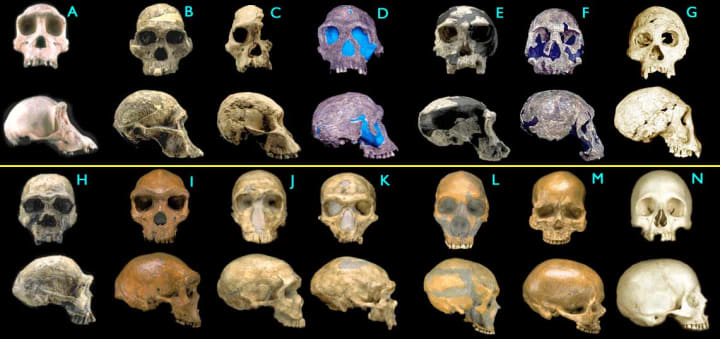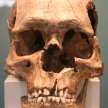
The photo above is an old shot of Willy Shoemaker, the jockey, and Wilt Chamberlain, the basketball player. Willy is not a dwarf of any kind. He is 4'11" tall. Wilt is not a giant. He is 7'1" tall. There is no argument—they are both Homo sapiens. What if you found their bones at an anthropological dig site? If you knew nothing about humans, you might think they represented two distinct species. After all, their skulls would have different volumes, and their postcranial bones would appear quite different from each other. This is what researchers face. Variation in a species can be enormous. There are so many classifications of hominins that it boggles the mind. Here is a list of some: Homo habilis, rudolfensis, antecessor, ergaster, erectus, heidelbergensis, floresiensis, neanderthalensis, gautengensis, cepranensis, naledi, tsaichangensis, rhodensiensis, georgicus, Denisovans, and Red Deer Cave People. This is not a complete list. There are many reasons that the taxonomy (classification) of Homo is so complicated. Some species coexisted, but they also cross mated, making all of these early hominins blends of each other. Each researcher has his own idea of who begat whom, and what makes a fossil Homo. Everyone has an opinion and no one agrees with anyone else. There is no standard among scientists, and the entire naming process is getting out of hand. Anyone who finds a fossil these days is claiming to have found our oldest ancestor, the oldest Homo, or the "missing link." Just look at the situation that recently occurred in South Africa. Last year, Lee Berger proclaimed Homonaledi, a fossil found by his son, to be this ancient Homo who was already a member of our genus while Australopithecuseines like Lucy were running around. You could hear the laugh go around the paleo world when the fossils were found to be a mere 250,000 years old.
Hominin Skulls

Some anthropologists want to use the volume of the skill to differentiate Homo, and others want to use other body measurements or morphologies. Peer review is useless in offering a delineation among species types. Anyone who finds a fossil can name it whatever they want. This is not only confusing to everyone, it is bad science. Would an objective panel of researchers be able to restrict the naming policy? Maybe their own choice of fossil classification would be threatened. Egos must be put aside in favor of some sort of regulation. Can the scientific world tolerate this clique of philosophical whimsy? It is past time for someone to tame this insanity. There is a technique available for sorting out this mess. Major disputes over some specific fossils have unearthed a possible solution. The five skulls found in Dmanisi Greece, have stymied scientists all over the world. Some say they collectively make up a new species of Homo. Others believe they are two separate species and so on. Homo floresiensis, the Hobbit, was thought to be a hominin with every pathology out there, and he was a dwarf as well. Some very ingenious scientists found a way to make sense of all of this.
Dmanisi Skulls

By using an analytical idea from the 18th century, Mana Dembo, Nicholas J. Matzke, Arne Ø. Mooers, and Mark Collard found a way to beat the name game. They are Canadians, except for American Nicholas J. Matzke. They took measurements of the skulls, fed these into a computer and applied Bayesian analytics using a supermatrix, which involves a standardized set of procedures and formulae to execute a calculation. These scientists came up with answers that make sense. The Dmanisi skulls represent 2 species, and the Hobbit is definitely a member of the Homo genus. We need more of this kind of analyses to make hominin taxonomy understandable and uniform. To read the study where they applied Bayesian analytics to controversial fossils, CLICK HERE.
About the Creator
Monica Bennett
I am a retired high school and college teacher. I have taught forensics, biology, chemistry, ecology, and Earth science.. Long Island has been my home for 60 years.






Comments
There are no comments for this story
Be the first to respond and start the conversation.